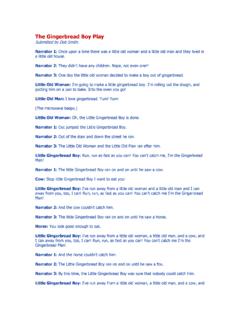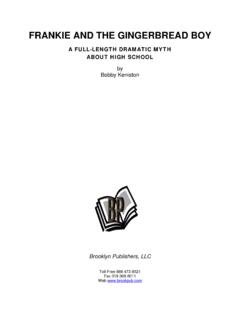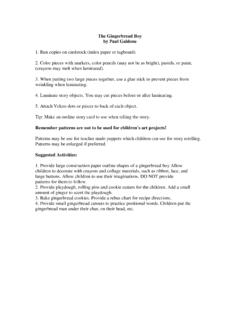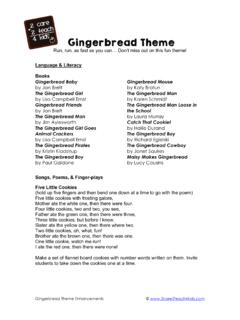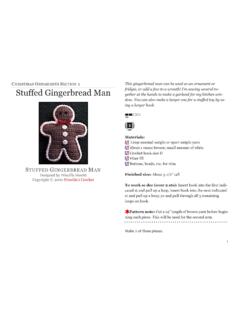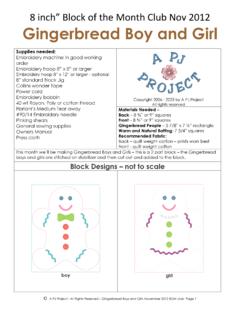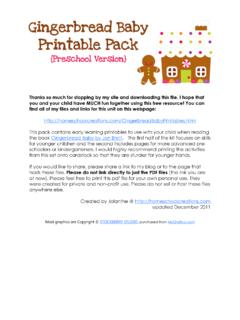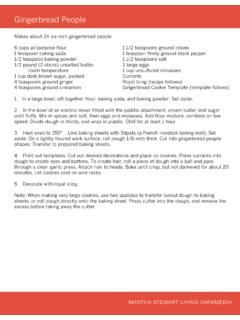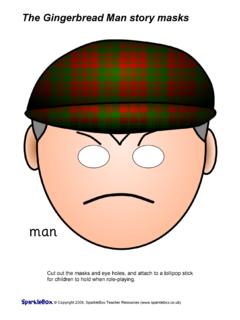Transcription of Goodness, Gracious! It’s Gingerbread! - The Mailbox
1 goodness , gracious ! It s Gingerbread! gingerbread GraphingRecording data on a bar graph Read aloud The gingerbread Boy by Paul Galdone. Discuss how the old woman made the gingerbread boy with flour, water, and spices. On the board, help children list some of the ingredi-ents used in gingerbread . Pass around spice containers of ground ginger, allspice, cinnamon, and cloves for students to sniff. Ask children if they have smelled warm gingerbread right out of the oven. Have them name some mouth-watering adjectives to describe gingerbread . Then tempt students taste buds with this graphing idea. As a class, make gingerbread men using the recipe below. Or bake them ahead of time and provide one gingerbread man for each child. For graphing practice, provide each child with a copy of the reproducible record sheet on page 9.
2 Next, give each child a gingerbread cookie and tell him to take only one bite out of it. Together record the results of the gingerbread tasting. Graph which part of the gingerbread cookie was eaten first head, arm, foot, or body. Determine which part was the most commonly eaten and the least commonly eaten. Finally, allow children to enjoy the rest of their gingerbread cookies! The scrumptious smell of spicy gingerbread is sure to get your students attention. Try these tempting treats and ideas to reinforce skills across the curriculum. ideas by Nicole Iacovazzi gingerbread Cookies1 1/2 c. molasses1 c. packed brown sugar2/3 c. cold water1/3 c. shortening6 1/2 c. flour Mix together molasses, brown sugar, water, and shortening.
3 Add all other ingredients and cover for 2 hours. Heat oven to 350 . On a floured surface, roll out dough until it is one-fourth inch thick. Cut out gingerbread men with cookie cutters and place them on a greased cookie sheet. Bake 10 minutes and cool. Dec-orate with frosting; use raisins for eyes and red cinnamon candies for buttons if tsp. ginger1 tsp. cinnamon1 tsp. allspice1 tsp. clovesDear Friend, I hear that you ve read my story! I just wanted to tell you that the ending is all wrong. I was never meant to be eaten by that tricky fox! Please help me! Can you please write my story a new way so that I DON T get eaten in the end? I want to be able to play with all my ginger-bread friends! I hope you can save me! Thanks! Your pal, The gingerbread Boy5 Save the gingerbread Boy!
4 Writing an alternative story ending In The gingerbread Boy by Paul Galdone, the quick but arrogant cookie-boy is eaten when he is outsmarted by a fox. Of course gingerbread boys are made to be eaten, but what if this one got away? After reading the book, have your students name ways to rescue the gingerbread Boy from the fox. Then engage students in this follow-up activity that results in a clever bulletin board display. To prepare for the activity, write the letter shown on chart paper. Fold the letter and place it in a large envelope addressed to your class. Open the envelope in front of the students and read the letter together. Ask students to think of new endings for the story in which the Ginger-bread Boy survives. Then, in reply to the letter, have students write their own stories in which the gingerbread Boy is saved from the fox.
5 To create a bulletin board, enlarge, color, and cut out the pattern on page 10 to make a large gingerbread Boy. Mount it in the center of a bulletin board along with the letter. Add student stories and the title Save the gingerbread Boy! Your students and guests will enjoy reading these happy endings!Run, Run, As Fast As You Can!Summarizing story events, retelling a story In the story The gingerbread Boy, there is a continuing pattern of the gingerbread Boy being chased by different characters who claim they can catch him. After reading the story, discuss the recurring words and phrases. Ask students to name the characters and list them as they appear in the story from start to finish. Then have the class summarize each event with a brief sentence (for example, The gin-gerbread boy was chased by a cow ).
6 Write the sentences in order on the board. Next, divide the class into pairs. Assign each pair a sentence to write on a sheet of drawing paper and then have them illustrate it. When the illustrations have been completed, have partners hang their pages in order on a clothes-line across the room. Have students use the sequence of events to help them retell the gingerbread Boy SearchExpository writing, following written directions Who can catch the gingerbread Boy? Maybe your students can! Help your class learn to write details and follow directions with this cooperative lesson. Use the pattern on page 10 to make several gingerbread Boy cutouts. Divide the students into groups and give each group one cutout. Ask each group to hide its gingerbread Boy in your classroom and then write directions explaining how he can be found.
7 Collect the directions from all groups. A search for the gingerbread Boy can now begin! Redistribute the directions. In turn, have each group read the directions aloud and locate the hidden cutout. After all groups find the gingerbread Boy s hiding places, discuss what makes a good set of the gingerbread PathCreating a visual aid to plan a story This activity reinforces mapping skills and encourages recall of The gingerbread Boy. To prepare students for mapping the adventures of the gingerbread Boy, provide the reproducible on page 11 for each student to complete. To stimulate creative thinking, ask each student to think of a new adventure for the gingerbread Boy. Ask students, Who or what might our nimble cookie-hero meet at the zoo, at the circus, on a camping trip, or at an amuse-ment park?
8 Provide drawing paper for each student to create his own adventure map. Have each student draw the places to which his Ginger-bread Boy traveled. Tell each student to draw arrows to show the sequence in which the gingerbread Boy visited these places. Then have students trade maps. As the storyteller describes his Adventures of gingerbread Boy, the listener follows the arrows. Now that s a path to success!Charles6 Units of gingerbread MeasurementMeasuring area and perimeterin nonstandard units Students are sure to love this sweet, hands-on approach to determining area and perimeter! Give each student a copy of the reproducible on page 12 and one cup of each of the following in individual zippered plastic bags: mini marsh-mallows, cinnamon hearts, jelly beans, and raisins.
9 The student finds the area and perim-eter of the gingerbread boy using each of the items. Each child records his answers on the grid. This activity helps students learn that it takes fewer large units than small units to cover an area or outline a shape (perimeter). Students can measure the sweetness of this activity when they complete the center and munch on their Gem of a gingerbread ManDiscriminating hard and soft sounds of g Give your students practice with learning the soft sound of g, as in gingerbread . Lead your students in a discussion of the two sounds that g can make: g as in gas and g as in gingerbread . Brainstorm a list of words that contain the soft sound of g such as gem, gel, gerbil, general, George, gym, and gen-tle and write them on the board.
10 Then give each student a brown construction paper copy of the pattern on page 10. Ask each child to cut out the gingerbread man and write soft g words on it. Allow students to work in small groups or with a buddy to find more words with the soft g contributed by Alma HoffmanConversations With a CookieWriting from a character s perspective For some critical-thinking and creative-writing practice, have each student interview the gingerbread Boy or another character from the story. Ask students, If you were a news reporter interviewing the gingerbread Boy today, what question would you ask? What would you ask the horse, the fox, or another character in the story? Have each student think of one question for a character and write it on an index card.

